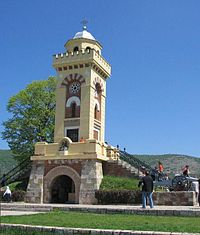| Battle of Čegar | |||||||
|---|---|---|---|---|---|---|---|
| Part of First Serbian uprising | |||||||
 Monument to commemorate on the Battle of Čegar Hill | |||||||
| |||||||
| Belligerents | |||||||
|
|
| ||||||
| Commanders and leaders | |||||||
|
|
| ||||||
| Strength | |||||||
| 10,000 troops | ~20,000 - 30,000 troops | ||||||
| Casualties and losses | |||||||
| ~1,000 - 3,000 killed | ~1,000 - 3,000 killed and wounded | ||||||
| |||||
The Battle of Čegar (April 15, 1809 – May 31, 1809) was a military engagement that occurred of the First Serbian Revolutionary War near Fortress of Niš against the Ottoman Empire.
Battle[]
Serbian offensive[]

Hursid Pasha

Stevan Sinđelić at Battle of Chegar Hill.
On April 15, 1809, the Serbian Revolutionary Army with its 10,000 soldiers approached the villages of Kamenica, Gornji and Donji Matejevac, near the Fortress of Niš with Miloje Petrović as Commander-in-chief. The Serbian soldiers made six trenches. The first and the biggest one was on Čegar Hill in charge of Duke Stevan Sinđelić. The second one was in the village Gornji Matejevac with Petar Dobrnjac as the commander. The third trench was North-east to Kamenica with Duke Ilija Barjaktarević. The fourth trench was in Kamenica with Miloje Petrović as the chief commander. The fifth trench was in the mountain above Kamenica and under the control of Duke Pauljo Matejić while the sixth one was in Donji Matejevac. The Ottoman commander of the fortress was Hursid Pasha who had 8,000 troops in fort and the surrounding area. The Serbs then launched several attacks against the Niš Fortress, but they could not take the fort due to lack of heavy artillery. In such circumstances, their strategy was to force with the long siege to surrender Hursid Pasha. But Hurshid was have different tactics, after every Serbian attack, he was offered negotiations buying on such way time while his arrives aid in the fresh troops.
Ottoman counterattack[]
Meanwhile, on 20 May the Ottoman army was reinforced with 20,000 soldiers from Rumelia. One Ottoman unit then tried to encircle the Serbian troops, 30 kilometres east of the town. Veljko Petrovic and his 2,000 soldiers then left their position, and moved to prevent the Ottoman attack from their rear approach. This manoeuvre further weakened revolutionary positions on the main front line. The Ottoman troops attacked on the trench of Petar Dobrnjac on 30 May. The following day, on May 31, 1809, the most prominent trench at Čegar Hill, under the command of Stevan Sinđelić, was under attack. The battle lasted for the whole day. Stevan and his Brigade became separated from the remainder of the Serb guerrilla positions and he and his men resisted fiercely. With hundreds of Ottoman soldiers pouring into the trench, Stevan saw that his Brigade had little hope of staving off the Ottoman offensive. Hand-to-hand combat ensued in the trenches. Stevan decided to fire his flintlock pistol into a pile of gunpowder kegs. When the Ottomans swarmed the trench from all sides and headed for him, Sinđelić squeezed the trigger. As Milovan Kukić witnessed:
"The Ottoman troops attacked five times, and the Serbs managed to repulse them five times. Each time their losses were great. Some of the Ottoman troops attacked, and some of them went ahead, and thus when they attacked for the sixth time they filled the trenches with their dead so that the alive went over their dead bodies and they began to fight against the Serbs with their bayonets, cutting and stabbing their enemies. The Serbian soldiers from the other trenches cried out to help Stevan. But there was no help, either because they could not help without their cavalry, or because Miloje Petrović did not allow it. When Stevan Sinđelić saw that the Ottoman troops had taken over the trench, he ran to the powder cave, took out his gun, and fired into the powder magazine. The ensuing explosion was so powerful that all of the surroundings were shaken, and the whole trench was caught in a cloud of dense smoke. Everyone that was in the trench was killed, as was everyone in the vicinity of it."
Aftermath[]
The fall of Sinđelić's trench forced the other Brigades of the Serbian Revolutionary Army to retreat back to the town of Deligrad, where they entrenched themselves in a new, fortified front line. When Hursid Pasha of Niš realized that, even though the post at Chegar hill had been taken, he ordered that the heads of the Serb victims be collected, skinned, and that the skulls be built into the Tower. This Tower was built along the road to Constantinople, as a warning to anyone rising against the Ottoman Empire. Defeat of the Serbian Revolutionary Army in this battle was meaning the lost initiative in the war, which lasted until 1813. Thousands Serbian revolutionaries and Ottoman troops were killed on Čegar Hill.[2] In 1815 was started Second Serbian Revolutionary War under the leadership of Miloš Obrenović.
References[]
See also[]
| ||||||||||||||
| ||||||||||||||||||||||||||||||||||||||||||
The original article can be found at Battle of Čegar and the edit history here.